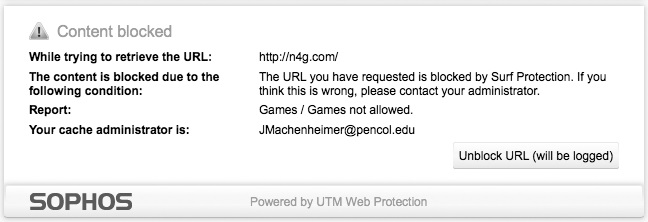
By Giovanni Roverso
Peninsula College’s Information Technology department was due to finalize Internet upgrades over winter break. But when winter quarter began, it was soon apparent that something had gone awry according to PC’s Director of IT, Steve Baxter. The devices connecting to the internet through the college network were suffering due to unknown reasons, the new firewall made by Sophos has been causing frustration for both students and faculty, and students failed to see expected improvements in Wi-Fi connectivity at the Pirate Union Building.
WHODUNNIT?
Baxter’s department was puzzled when weird things started happening a few days after the quarter started. The upgrades had seemingly been completed as planned and network diagnostics seemed to be coming back clean, but when returning students and faculty put the new system under full load, it just didn’t match up to expectations, he said. Modern services like Netflix, Skype, and YouTube were functional to a degree, but more connection-sensitive services like conference calling over interactive TV would experience severe slowdowns seconds after the 720p video stream was established.
Overall, things were worse than before.
Download speeds that should have been upwards of 50 Megabits per second on wired machines would instead linger in the 1-2Mb/s range. Thinking it was the new hardware, the IT department switched back to the old system and tellingly, the problems persisted.
It was difficult to determine who was to blame at first since the upgrade process depended on multiple parties working together flawlessly, Baxter said. Due to Port Angeles’ relatively remote location, the college’s Internet pipe is owned and managed by at least four different service providers making the situation even more complex.
After a lot of time spent troubleshooting, dealing with bureaucracy, and assuring the Internet Service Providers that the issue with the border router was not coming from the college, IT got them to perform checks on their end. Wave Broadband which acquired the last mile of cabling closest to the college didn’t see any issue. Farther down the line was Public Utility District, PUD, whose supportive staff was lauded by Baxter. It also turned up clean. In the end it was found that both Northwest Open Access Network, NoaNet, and the K20 Education Network were both guilty of misconfiguring its settings.
On Feb. 19 Baxter said things were finally working how they were supposed to, with the college’s overall download speed at 100Gb/s and a 55Mb/s average speed per download. The results made Baxter confident enough to give PCWNETS a long-awaited boost from two to 10Mb/s. He said will consider boosting it another 10Mb in the future if all goes well.
Issues remained shortly thereafter with the college’s two wireless controllers, of which one was just installed along with the other upgrades. Since the K20 repair however, and after some troubleshooting, things have begun to run fine, Baxter said, allowing a total of 128 simultaneous connections, double compared to before.
SOPHOS
The brand new Sophos firewall put in place over winter break has also caused some stress on campus. Essentially it’s really good at what it does: blocking webpages. Baxter explained that it filters in two ways. One which has lifted a hefty burden off of the IT department’s shoulders is Sophos’ built-in intelligence, which works to detect and shut out attacks to the local network. He said attacks come in 24/7. These used to be a real pain since they had to shut the worst ones down manually. Sophos now deals with 100 percent of attacks automatically. Also the system scans sites for malicious code and blocks them too to keep computers clean. It used to be that IT would have to completely refresh Windows on several machines every week because of accidentally installed malicious software.

The other method consists of manually blocking sites related to certain topics such as hardcore pornography, gaming and hate sites. This has caused more of a stir since it has blocked some sites that instructors use in their classes. One instructor, Renne Brock-Richmond, uses the online virtual reality game Second Life in her classroom and had to get an exception made for it.
There has been much confusion around how exactly to make a page accessible. When content gets blocked, a page with a prompt to unblock it appears. Instructors have attempted this to no avail. Baxter admitted that the “Unblock URL” button is not actually set up to relay messages to the IT department, so if you need to get something opened up you’ll have to contact PC’s network administrator Jerry Machenheimer at jmachenheimer@pencol.edu.
What about that Wi-Fi in the PUB?
The PUB wi-fi performance has also been less than stellar recently. Few students have had much luck connecting to PCWNETS there at all. Such didn’t quite make sense considering the network just got a download speed boost from 2Mb/s to 10Mb/s. The PUB used to house three wireless access points: one broadcasting from The Bookaneer book store, one near the end of the hallway that starts in front of The Bookaneer and one around the ATM machine, closer to the book store. Upon investigation by the IT department at the end of February it was found that the transmitter near the ATM was never put back in place after remodeling had been done last spring. A work request was put in to set the area up again for new more powerful access points that work in the 5GHz frequency range beyond the standard 2.4GHz.
Currently, the missing transmitter near the ATM has been replaced. Baxter’s department is also waiting on an order for another access point to be installed soon near the Associated Student Council offices on the west end of the PUB
